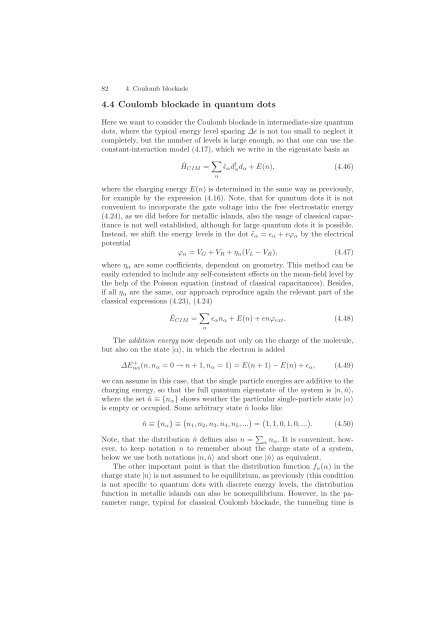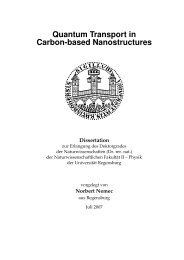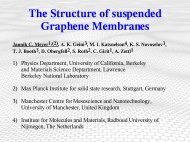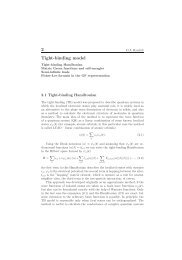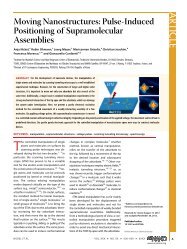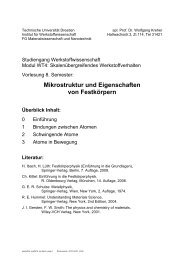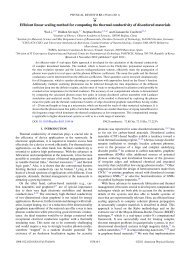4 Coulomb blockade
4 Coulomb blockade
4 Coulomb blockade
Create successful ePaper yourself
Turn your PDF publications into a flip-book with our unique Google optimized e-Paper software.
82 4 <strong>Coulomb</strong> <strong>blockade</strong><br />
4.4 <strong>Coulomb</strong> <strong>blockade</strong> in quantum dots<br />
Here we want to consider the <strong>Coulomb</strong> <strong>blockade</strong> in intermediate-size quantum<br />
dots, where the typical energy level spacing ∆ɛ is not too small to neglect it<br />
completely, but the number of levels is large enough, so that one can use the<br />
constant-interaction model (4.17), which we write in the eigenstate basis as<br />
ˆHCIM = <br />
α<br />
˜ɛαd † αdα + E(n), (4.46)<br />
where the charging energy E(n) is determined in the same way as previously,<br />
for example by the expression (4.16). Note, that for quantum dots it is not<br />
convenient to incorporate the gate voltage into the free electrostatic energy<br />
(4.24), as we did before for metallic islands, also the usage of classical capacitance<br />
is not well established, although for large quantum dots it is possible.<br />
Instead, we shift the energy levels in the dot ˜ɛα = ɛα + eϕα by the electrical<br />
potential<br />
ϕα = VG + VR + ηα(VL − VR), (4.47)<br />
where ηα are some coefficients, dependent on geometry. This method can be<br />
easily extended to include any self-consistent effects on the mean-field level by<br />
the help of the Poisson equation (instead of classical capacitances). Besides,<br />
if all ηα are the same, our approach reproduce again the relevant part of the<br />
classical expressions (4.23), (4.24)<br />
ÊCIM = <br />
ɛαnα + E(n)+enϕext. (4.48)<br />
α<br />
The addition energy now depends not only on the charge of the molecule,<br />
but also on the state |α〉, in which the electron is added<br />
∆E + nα(n, nα =0→ n +1,nα =1)=E(n +1)− E(n)+ɛα, (4.49)<br />
we can assume in this case, that the single particle energies are additive to the<br />
charging energy, so that the full quantum eigenstate of the system is |n, ˆn〉,<br />
where the set ˆn ≡{nα} shows weather the particular single-particle state |α〉<br />
is empty or occupied. Some arbitrary state ˆn looks like<br />
ˆn ≡{nα} ≡ n1,n2,n3,n4,n5, ... = 1, 1, 0, 1, 0, ... . (4.50)<br />
Note, that the distribution ˆn defines also n = <br />
α nα. It is convenient, however,<br />
to keep notation n to remember about the charge state of a system,<br />
below we use both notations |n, ˆn〉 and short one |ˆn〉 as equivalent.<br />
The other important point is that the distribution function fn(α) inthe<br />
charge state |n〉 is not assumed to be equilibrium, as previously (this condition<br />
is not specific to quantum dots with discrete energy levels, the distribution<br />
function in metallic islands can also be nonequilibrium. However, in the parameter<br />
range, typical for classical <strong>Coulomb</strong> <strong>blockade</strong>, the tunneling time is


